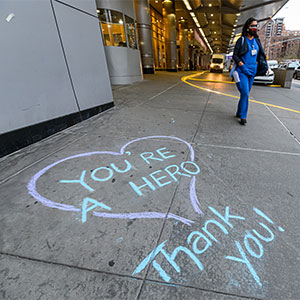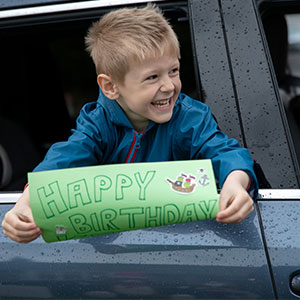
You are a part of history.
You are living through an important and unique time in history—the COVID-19 pandemic. Years from now, historians will learn from the experiences of people who went through it—people like you and your family.
That’s why we want you to be part of our My History project.
Project Ideas
Here are 9 ideas for how you can document your experiences.
Choose one, combine a few, or invent your own.
Note: Since we launched the My History Project for students to document living through the COVID-19 pandemic, another historic moment has arisen in our country: The unjust and tragic murder of George Floyd and the outpouring of grief and protests over systemic racism and violence against Black people in the United States. We welcome and support students' responses to this time in history as well.
1. Observe the world around you.
Document what you see in a field journal. You can look out a window or sit on your doorstep. (Just make sure to follow social distancing guidelines.) Do this regularly—for example, every Friday morning. Keep two sections in your field journal:
- Observations: Record the date, time, and your location (“my room”, “my backyard," not your address). Then record what you observe. For example: What do you see? What do you hear? What do you smell? What are people talking about? You can record your observations as written notes and/or drawings.
- Reflections: Reflect on what you observe. For example, how is what you’re observing different from or similar to what you usually see? Have things changed since last week? If so, how? How does what you’re seeing make you feel?
- Remember, there are many ways to keep a journal. It can include lists, sketches, clippings, and more. Get helpful ideas about journaling from this Scholastic Choices article
2. Write a news story about your family.
Interview everyone who lives in your home about how they’re feeling and spending their time, as well as what they are thinking about. Here are some questions you can ask:
- What has changed?
- What has surprised you?
- What makes you feel worried?
- What makes you feel hopeful?
- Have you learned anything new during this time? Have you taught anything new to someone else?
- What do think you’ll remember when you look back on this time?
Turn your interviews into a news story in the form of a written article, podcast, or short video. Be sure to include quotes. Don't miss these helpful hints on creating riveting news story from a Scholastic Kid Reporter. For some great tips on conducting and recording an interview, check out the StoryCorps app.
Note: If you plan to submit your story to Scholastic, make sure everyone you interview understands it’s for a project you’ll be submitting and that your story may be selected to be published in print and online.
3. Keep a kindness list.
Record the ways you’ve been a helper and the ways others have helped you, such as pitching in with housework or childcare, or reaching out to someone who seems lonely or scared. You can also include moments you’ve seen in the world around you, on TV, or on the internet of friends, family members, and community members having a positive impact on one another. Remember, even the smallest action can make a big difference. Share your record as a written list or in the form of a video, podcast, or picture book.
(Note: If you include the names of other people, be sure to get their permission.)
4. Put yourself in someone else’s shoes.
Imagine you are someone else—a friend of yours, one of your teachers, a waiter, a grocery store cashier, a nurse, a member of your family, etc. Think about what that person’s life might be like, how they might be feeling right now, questions you have for them, and why you feel grateful for them. Then write that person a letter. Click on these links for templates to help you plan and write your letter.
5. Be a photojournalist.
Here are some things you might document with photos:
- What’s happening in your home at different times of the day, such as at meals, school time, or in the evening.
- Symbols of unity you see in your neighborhood, such as chalk rainbows or cheers for healthcare workers.
Put your pictures together in a collage or slideshow, with captions explaining each one. If you take a picture of someone else, be sure to get that person's permission.
7. Document your daily routines.
In a journal, create a schedule of a typical day for you back in February. Then record your daily activities over the next week. What are you doing to keep busy? How are you communicating with friends? What do you miss most about your old routine? What do you miss the least? Are there parts of your new routine that you’d like to continue once life starts to return to normal? Create a picture book or a graphic novel about your life.
9. Record digital trends.
Keep a record of the videos, songs, games, podcasts, and books you’re enjoying during this time. If you’re a middle schooler or older, keep a record of the videos, memes, hashtags, and other digital content that is trending among people your age right now. What does this content show about how young people are dealing with the crisis?
Don't forget: if you decide to submit your project and you are including other people in your submission either by name or in a photo or video, be sure to get their permission.
Don't forget: if you decide to submit your project and you are including other people in your submission either by name or in a photo or video, be sure to get their permission.
If you are having a tough time managing hard feelings, you can text the Crisis Text line at 74141 to find help. You are not alone.
If you are having a tough time managing hard feelings, you can text the Crisis Text line at 74141 to find help. You are not alone.
Photo Credits: HERO: Roy Jones/Evening Standard/Getty Images (Crowd of Children); Corbis via Getty Images (Drummer Boy); FatCamera/Getty Images (Modern Kids); NBCU Photo Bank/NBCUniversal via Getty Images (Paperboy); iStockPhoto/Getty Images (Climate Protest); Ronald Patrick/Getty Images (Greta Thunberg) SITE: Monkey Business Images/Shutterstock.com (1); fizkes/Shutterstock.com (2); Wavebreak Media/Offset (3); SDI Productions/Getty Images (4); Noam Galai/Getty Images (5); svetikd/Getty Images (6); Justin Paget/Getty Images (7); wavebreakmedia/Shutterstock.com (8); Supawadee56/Shutterstock.com (9); John Moore/Getty Images (10); mixetto/Getty Images (11)
PRIVACY POLICY | Terms of Use | TM ® & © 2020 Scholastic Inc. All Rights Reserved.










